FAMILY MYRMECOBIIDAE Numbat
|
|
Numbat Myrmecobius fasciatus
is a unique and specialized marsupial, the only member of the family
Myrmecobiidae in the order Dasyuromorphia, the carnivorous marsupials.
Once widespread across southern Australia, it is now restricted to
eucalypt woodlands in the extreme southwest.
About the size of a small fox, with a stout muzzle and long bushy tail,
it feeds primarily on termites. Although it has strong claws, it cannot
open the concrete-like termite mounds, so it must search for termite
activity during the day. In the Aussie winter this is mid-day, but
during the summer it is active early and late in the day. There is no
other mammal on earth that is anything like this diurnal marsupial.
Photos 6 Aug 2008 at Dryandra Forest, Western Australia, Australia |
|
 Finding
and photographing (hopefully!) this rare and special mammal was a prime
focus of our August 2008 trip to southwestern Australia. Frank O'Connor's web site had useful tips for finding them at Dryandra Forest, where a remnant population still exists; "Project Numbat"
had information about life history and reintroduction projects. We
planned a 3-day visit to Dryandra (right), visiting daily from our
motel in the town of Narrogin, about a half-hour drive to the southeast. Finding
and photographing (hopefully!) this rare and special mammal was a prime
focus of our August 2008 trip to southwestern Australia. Frank O'Connor's web site had useful tips for finding them at Dryandra Forest, where a remnant population still exists; "Project Numbat"
had information about life history and reintroduction projects. We
planned a 3-day visit to Dryandra (right), visiting daily from our
motel in the town of Narrogin, about a half-hour drive to the southeast.
The Dryandra Forest,
now proposed as a National Park, is a growing reserve of parcels of
remnant wondoo eucalypt woodlands. Well-maintained dirt roads
criss-cross the forest, from broad main drives (like Tomingley Road,
above) to smaller dirt tracks. The forest is excellent for the eucalypt
birds of southwestern Australia, including a number of endemics, and
has recently become the site of major reintroduction projects for
several endangered mammal. One project is called Barna Mia, a huge
fenced enclosure to keep out non-native foxes and cats but otherwise
open woods, that can be visited at night with a guide toting a
red-light spotlight; we did so and very much enjoyed that experience.
We also saw Western Gray Kangaroo Macropus fuliginosus, Tammar Wallaby Macropus eugenii, Bush-tailed Bettong [Woylie] Bettongia penicillata, and Common Brushtail Possum Trichosurus vulpecula (a unique form with white-tipped tail is here) during night drives along these tracks through the forest. |
|
| The
Numbat, though, is found only during the day, and only with luck. Each
home range is large — over 350 acres (=150 hectares) — and each Numbat
forages alone, so the odds of seeing one is comparatively small. We
took several hikes through the forest but our search for Numbat was
focused mostly on slowly driving the roads. We found evidence at
several sites of recent termite activity (above left), and found what
looked to be recent Numbat tracks (above right), so we drove these
roads several times. From this evidence, and suggestions from Frank
O'Connor, we worked Tomingley, Gura, Baaluc, Norman, Marri, Norn,
Mangart (site of the termite activity, above), and Patonga roads over
our three-day search. We often circled back through Lions Dryandra
Woodlands Village, site of the caretaker's home and cottages at can be
rented by those with camping gear, as a Numbat had been seen there a
couple days earlier at mid-day. |
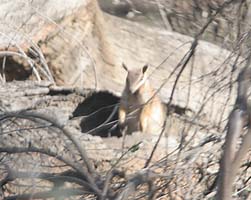 It
was about 3 p.m. on our final afternoon, some 17 hours into our search,
near the junction of Marri and Tomingley roads, when a Numbat ran
across the road in front of our car. It carried its tail high and
cocked up over its back as it trotted by as if on a mission. We stopped
the car and thought about trying to follow it into the woods, but
before we could get out of the car, the Numbat ran back across the road
and hopped up on a log (right; a bad shot taken through the
windshield). It posed upright, like a prairie-dog, for a bit, and then
disappeared into a hollow log. I jockeyed the car forward to await its
reappearance, but suddenly we noticed the Numbat had come out of the
other end of the log, which was obviously hollow throughout. We backed
up slowly and Rita was able to get some video, while I managed two
shots (top of page) before it ran off into the woods. It
was about 3 p.m. on our final afternoon, some 17 hours into our search,
near the junction of Marri and Tomingley roads, when a Numbat ran
across the road in front of our car. It carried its tail high and
cocked up over its back as it trotted by as if on a mission. We stopped
the car and thought about trying to follow it into the woods, but
before we could get out of the car, the Numbat ran back across the road
and hopped up on a log (right; a bad shot taken through the
windshield). It posed upright, like a prairie-dog, for a bit, and then
disappeared into a hollow log. I jockeyed the car forward to await its
reappearance, but suddenly we noticed the Numbat had come out of the
other end of the log, which was obviously hollow throughout. We backed
up slowly and Rita was able to get some video, while I managed two
shots (top of page) before it ran off into the woods.
Perhaps I don't need to say this was a heart-pounding experience! |
|
|
| Later
in our 2008 trip we visited Desert Park in Alice Springs, which is an
open-air zoo focusing on Australia biota. Among the many large
flight-cages for birds, and a wonderful 'nocturnal house' that permits
one to see several rare night critters, is a large enclosure with a
Numbat. |
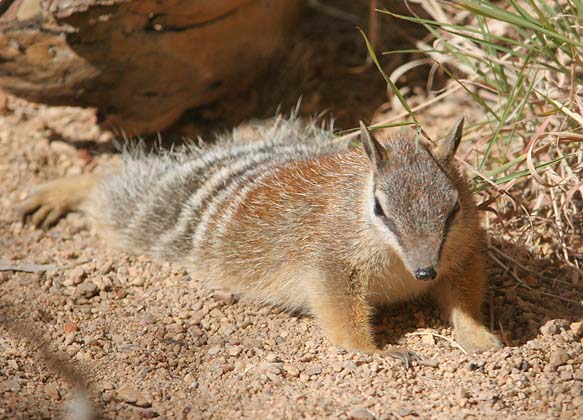 These
final photos were taken of the Numbat there. During our visit, the
captive Numbat engaged in several behaviors we had seen in the wild —
such as running through hollow logs or standing upright — and several
we did not see, including sun-bathing (right) and running its long,
sticky tongue. Numbat has very ineffective teeth, and it uses that
tongue to eat 20,000 termites a day. It has an ability to locate
termite galleries by scent, and sniffs for them while standing on its
hind legs (Cronin 1991, Menkhorst & Knight 2004). These
final photos were taken of the Numbat there. During our visit, the
captive Numbat engaged in several behaviors we had seen in the wild —
such as running through hollow logs or standing upright — and several
we did not see, including sun-bathing (right) and running its long,
sticky tongue. Numbat has very ineffective teeth, and it uses that
tongue to eat 20,000 termites a day. It has an ability to locate
termite galleries by scent, and sniffs for them while standing on its
hind legs (Cronin 1991, Menkhorst & Knight 2004).
|
|
Literature cited:
Cronin, Leonard. 1991. Key Guide to Australian Mammals. Illustrations by Marion Westmacott. Reed Books, Kew, Vict., Australia.
Menkhorst,
Peter, and Frank Knight. 2004. A Field Guide to the Mammals of
Australia. 2d ed. Oxford Univ. Press, South Melbourne, Australia.
|
TOP
Page created 30 Aug 2008 |
|
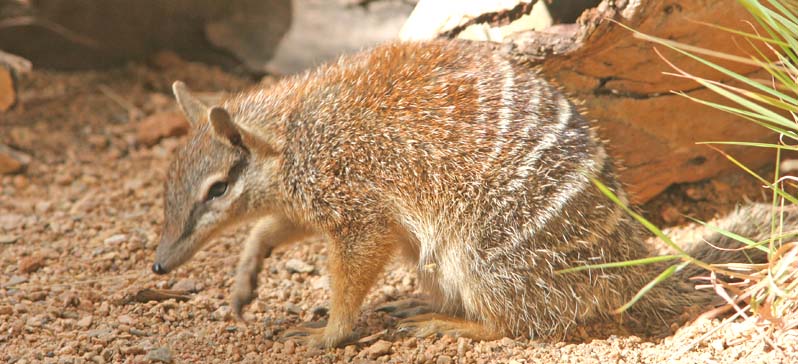
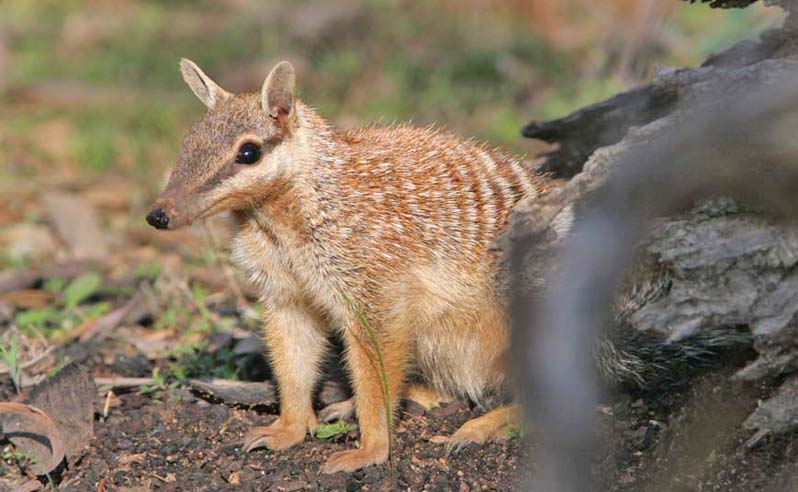
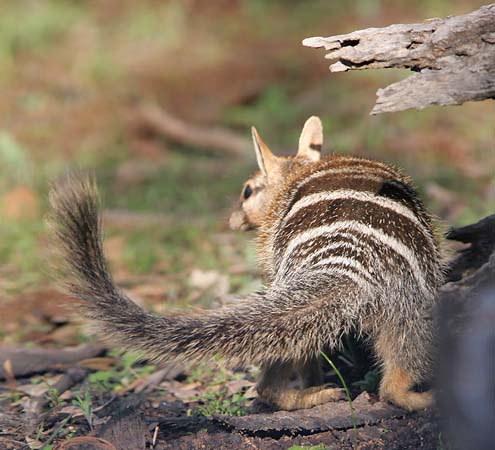
 Finding
and photographing (hopefully!) this rare and special mammal was a prime
focus of our August 2008 trip to southwestern Australia.
Finding
and photographing (hopefully!) this rare and special mammal was a prime
focus of our August 2008 trip to southwestern Australia. 

 It
was about 3 p.m. on our final afternoon, some 17 hours into our search,
near the junction of Marri and Tomingley roads, when a Numbat ran
across the road in front of our car. It carried its tail high and
cocked up over its back as it trotted by as if on a mission. We stopped
the car and thought about trying to follow it into the woods, but
before we could get out of the car, the Numbat ran back across the road
and hopped up on a log (right; a bad shot taken through the
windshield). It posed upright, like a prairie-dog, for a bit, and then
disappeared into a hollow log. I jockeyed the car forward to await its
reappearance, but suddenly we noticed the Numbat had come out of the
other end of the log, which was obviously hollow throughout. We backed
up slowly and Rita was able to get some video, while I managed two
shots (top of page) before it ran off into the woods.
It
was about 3 p.m. on our final afternoon, some 17 hours into our search,
near the junction of Marri and Tomingley roads, when a Numbat ran
across the road in front of our car. It carried its tail high and
cocked up over its back as it trotted by as if on a mission. We stopped
the car and thought about trying to follow it into the woods, but
before we could get out of the car, the Numbat ran back across the road
and hopped up on a log (right; a bad shot taken through the
windshield). It posed upright, like a prairie-dog, for a bit, and then
disappeared into a hollow log. I jockeyed the car forward to await its
reappearance, but suddenly we noticed the Numbat had come out of the
other end of the log, which was obviously hollow throughout. We backed
up slowly and Rita was able to get some video, while I managed two
shots (top of page) before it ran off into the woods. These
final photos were taken of the Numbat there. During our visit, the
captive Numbat engaged in several behaviors we had seen in the wild —
such as running through hollow logs or standing upright — and several
we did not see, including sun-bathing (right) and running its long,
sticky tongue. Numbat has very ineffective teeth, and it uses that
tongue to eat 20,000 termites a day. It has an ability to locate
termite galleries by scent, and sniffs for them while standing on its
hind legs (Cronin 1991, Menkhorst & Knight 2004).
These
final photos were taken of the Numbat there. During our visit, the
captive Numbat engaged in several behaviors we had seen in the wild —
such as running through hollow logs or standing upright — and several
we did not see, including sun-bathing (right) and running its long,
sticky tongue. Numbat has very ineffective teeth, and it uses that
tongue to eat 20,000 termites a day. It has an ability to locate
termite galleries by scent, and sniffs for them while standing on its
hind legs (Cronin 1991, Menkhorst & Knight 2004).